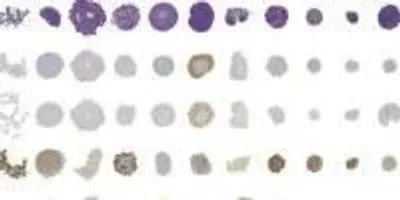 The cell lines are positioned in different columns, while the stains are arranged in rows. Top row: H&E staining, followed by staining for ER, PR, TP53 (P53), and Her-2 (cerbB-2). Scale bar is 500 μm.Image courtesy of Ivanov et al.
The cell lines are positioned in different columns, while the stains are arranged in rows. Top row: H&E staining, followed by staining for ER, PR, TP53 (P53), and Her-2 (cerbB-2). Scale bar is 500 μm.Image courtesy of Ivanov et al.
An SLAS Discovery original research report entitled "In Vitro Tissue Microarrays for Quick and Efficient Spheroid Characterization" describes a new technology that bridges the gap between clinical pathology assessment, high-content analysis, and 3D cell cultures. With the spheroid microarray technique scientists can probe spheroid phenotype, multiplex readouts, and analyze the results at the single cell level. The method arranges 66 spheroids in a gel array for paraffin-embedding, sectioning, and immunohistochemistry. The process is rapid, automatable, and uses 11 times fewer reagents compared to conventional workflows.
The authors demonstrate the advantages of their technique with a mixed array made up of spheroid models from 11 different cell lines. They stain all spheroids simultaneously and multiplex five different markers on adjacent sections. The staining, imaging, and analysis are automated. The authors openly share their protocols, designs, and ImageJ macros to enable other researchers to apply the technique for safety and efficacy testing as well as model optimization and characterization.
Three-dimensional cell cultures such as spheroids and organoids are being increasingly adopted in commercial and regulatory compound assessments. Along with organ-on-a-chip models these in vitro cultures are promising increased physiological relevance and therapeutic predictivity in both safety and efficacy screens.
Most methods to analyze these advanced models rely on simplistic measurements of live vs. dead cells. These reductionist assays provide little molecular insight into the targets and mechanisms of drug action. Moreover, the readouts are not comparable to clinical data, such as biomarker expression and tissue morphology.











